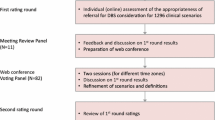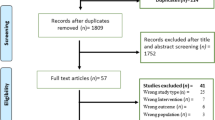Abstract
Background and objective
Although Deep Brain Stimulation (DBS) has been proven to be an effective treatment for patients with advanced Parkinson’s disease (PD), it may be difficult for general neurologists to identify appropriate candidates for this procedure. We developed an electronic decision tool that can assist neurologists in deciding which PD patients should be referred for DBS consideration.
Methods
Using the RAND/UCLA Appropriateness Method, an international expert panel assessed the appropriateness of referral for 972 theoretical patient profiles. Panel results were embedded in an electronic decision support tool which displays the panel statement on referral (appropriate, inappropriate and uncertain) after completion of the patient profile.
Results
Referral was considered appropriate for 33 % of the theoretical profiles. Logistic regression showed excellent internal consistency of the ratings (predictive value 92 %). Symptom severity (OFF-symptoms, dyskinesias, refractory tremor) and PD duration were positively associated with the panel judgment that referral is appropriate. Presence of levodopa-resistant axial symptoms, age ≥ 70 years and presence of cognitive impairment showed the strongest negative impact.
Conclusions
The RAND/UCLA method proved to be useful in determining the appropriate criteria for DBS referral. Validity and applicability of the decision tool (accessible via http://test.stimulus-dbs.org) in clinical practice need to be further determined.
Similar content being viewed by others
References
Brook RH, Chassin MR, Fink A, Solomon DH, Kosecoff J, Park RE (1986) A method for the detailed assessment of the appropriateness of medical technologies. Int J Technol Assess Health Care 2:53–63
Charles PD, Van Blercom N, Krack P, Lee SL, Xie J, Besson G, Benabid AL, Pollak P (2002) Predictors of effective bilateral subthalamic nucleus stimulation for PD. Neurology 59:932–934
Davis JT, Lyons KE, Pahwa R (2006) Freezing of gait after bilateral subthalamic nucleus stimulation for Parkinson’s disease. Clin Neurol Neurosurg 108:461–464
Deuschl G, Schade-Brittinger C, Krack P, Volkmann J, Schafer H, Botzel K, Daniels C, Deutschlander A, Dillmann U, Eisner W, Gruber D, Hamel W, Herzog J, Hilker R, Klebe S, Kloss M, Koy J, Krause M, Kupsch A, Lorenz D, Lorenzl S, Mehdorn HM, Moringlane JR, Oertel W, Pinsker MO, Reichmann H, Reuss A, Schneider GH, Schnitzler A, Steude U, Sturm V, Timmermann L, Tronnier V, Trottenberg T, Wojtecki L, Wolf E, Poewe W, Voges J; German Parkinson Study Group, Neurostimulation Section (2006) A randomized trial of deep-brain stimulation for Parkinson’s disease. N Engl J Med 355:896–908
Diamond A, Jankovic J (2005) The effect of deep brain stimulation on quality of life in movement disorders. J Neurol Neurosurg Psychiatry 76:1188–1193
Fahn SE, Elton RL, Members of the UPDRS Development Committee (1987) Unified Parkinson’s Disease Rating Scale. In: Fahn S, Marsden CD, Calne DB, et al. (eds) Recent Developments in Parkinson’s Disease. Vol. 2. Florham Park, NJ, USA: Macmillan Health Care Information, pp 153–164
Fitch K, Bernstein SJ, Aguilar MS, Burnand B, Ramon LaCalle J, Lazaro P, van het Loo M, McDonnell J, Vader J, Kahan JP (2001) The RAND/UCLA Appropriateness Method. User’s manual. www.rand.org/pubs/ monograph_reports/MR1269 (accessed 1 March 2008)
Gan J, Xie-Brustolin J, Mertens P, Polo G, Klinger H, Mollion H, Benatru I, Henry E, Broussolle E, Thobois S (2007) Bilateral subthalamic nucleus stimulation in advanced Parkinson’s disease: three years follow-up. J Neurol 254:99–106
Hughes AJ, Daniel SE, Kilford L, Lees AJ (1992) Accuracy of clinical diagnosis of idiopathic Parkinson’s disease: a clinico-pathological study of 100 cases. J Neurol Neurosurg Psychiatry 55:181–184
Kleiner-Fisman G, Herzog J, Fisman DN, Tamma F, Lyons KE, Pahwa R, Lang AE, Deuschl G (2006) Subthalamic nucleus deep brain stimulation: summary and meta-analysis of outcomes. Mov Disord 21(Suppl 14):S290–S304
Krack P, Batir A, Van Blercom N, Chabardes S, Fraix V, Ardouin C, Koudsie A, Limousin PD, Benazzouz A, LeBas JF, Benabid AL, Pollak P (2003) Five-year follow-up of bilateral stimulation of the subthalamic nucleus in advanced Parkinson’s disease. N Engl J Med 349:1925–1934
Lang AE, Houeto JL, Krack P, Kubu C, Lyons KE, Moro E, Ondo W, Pahwa R, Poewe W, Troster AI, Uitti R, Voon V (2006) Deep brain stimulation: preoperative issues. Mov Disord 21(Suppl 14):S171–S196
Lyons KE, Pahwa R (2005) Long-term benefits in quality of life provided by bilateral subthalamic stimulation in patients with Parkinson disease. J Neurosurg 103:252–255
Moro E, Lang AE (2006) Criteria for deep brain stimulation in Parkinson’s disease: review and analysis. Expert Rev Neurother 6:1695–1705
Okun MS, Fernandez HH, Pedraza O, Misra M, Lyons KE, Pahwa R, Tarsy D, Scollins L, Corapi K, Friehs GM, Grace J, Romrell J, Foote KD (2004) Development and initial validation of a screening tool for Parkinson disease surgical candidates. Neurology 63:161–163
Ostergaard K, Aa Sunde N (2006) Evolution of Parkinson’s disease during 4 years of bilateral deep brain stimulation of the subthalamic nucleus. Mov Disord 21:624–631
Pahwa R, Factor SA, Lyons KE, Ondo WG, Gronseth G, Bronte-Stewart H, Hallett M, Miyasaki J, Stevens J, Weiner WJ (2006) Practice Parameter: treatment of Parkinson disease with motor fluctuations and dyskinesia (an evidence- based review): report of the Quality Standards Subcommittee of the American Academy of Neurology. Neurology 66:983–995
Rodriguez-Oroz MC, Obeso JA, Lang AE, Houeto JL, Pollak P, Rehncrona S, Kulisevsky J, Albanese A, Volkmann J, Hariz MI, Quinn NP, Speelman JD, Guridi J, Zamarbide I, Gironell A, Molet J, Pascual-Sedano B, Pidoux B, Bonnet AM, Agid Y, Xie J, Benabid AL, Lozano AM, Saint-Cyr J, Romito L, Contarino MF, Scerrati M, Fraix V, Van Blercom N (2005) Bilateral deep brain stimulation in Parkinson’s disease: a multicentre study with 4 years follow-up. Brain 128:2240–2249
Schupbach WM, Chastan N, Welter ML, Houeto JL, Mesnage V, Bonnet AM, Czernecki V, Maltete D, Hartmann A, Mallet L, Pidoux B, Dormont D, Navarro S, Cornu P, Mallet A, Agid Y (2005) Stimulation of the subthalamic nucleus in Parkinson’s disease: a 5 year follow-up. J Neurol Neurosurg Psychiatry 76:1640–1644
Schupbach WM, Maltete D, Houeto JL, du Montcel ST, Mallet L, Welter ML, Gargiulo M, Behar C, Bonnet AM, Czernecki V, Pidoux B, Navarro S, Dormont D, Cornu P, Agid Y (2007) Neurosurgery at an earlier stage of Parkinson disease: a randomized, controlled trial. Neurology 68:267–271
Shekelle P (2004) The appropriateness method. Med Decis Making 24:228–231
Voon V, Kubu C, Krack P, Houeto JL, Troster AI (2006) Deep brain stimulation: neuropsychological and neuropsychiatric issues. Mov Disord 21 (Suppl 14):S305–S327
Welter ML, Houeto JL, Tezenas du Montcel S, Mesnage V, Bonnet AM, Pillon B, Arnulf I, Pidoux B, Dormont D, Cornu P, Agid Y (2002) Clinical predictive factors of subthalamic stimulation in Parkinson’s disease. Brain 125: 575–583
Author information
Authors and Affiliations
Consortia
Corresponding author
Additional information
* International Study Group on Referral Criteria for DBS: Niels Allert, Bonn, Germany; Philippe Damier, Nantes, France; Patricia Dowsey-Limousin, London, United Kingdom; Roberto Eleopra, Venice, Italy; Jan Herzog, Kiel, Germany; Jean-Luc Houeto, Poitiers, France; Elena Moro, Toronto, Canada; Karen Østergaard, Aarhus, Denmark; Patrick Santens, Ghent, Belgium; Francesc Valldeoriola, Barcelona, Spain; Hakan Widner, Lund, Sweden; Maurizio Zibetti, Turin, Italy.
Rights and permissions
About this article
Cite this article
Moro, E., Allert, N., Eleopra, R. et al. A decision tool to support appropriate referral for deep brain stimulation in Parkinson’s disease. J Neurol 256, 83–88 (2009). https://doi.org/10.1007/s00415-009-0069-1
Received:
Revised:
Accepted:
Published:
Issue Date:
DOI: https://doi.org/10.1007/s00415-009-0069-1




